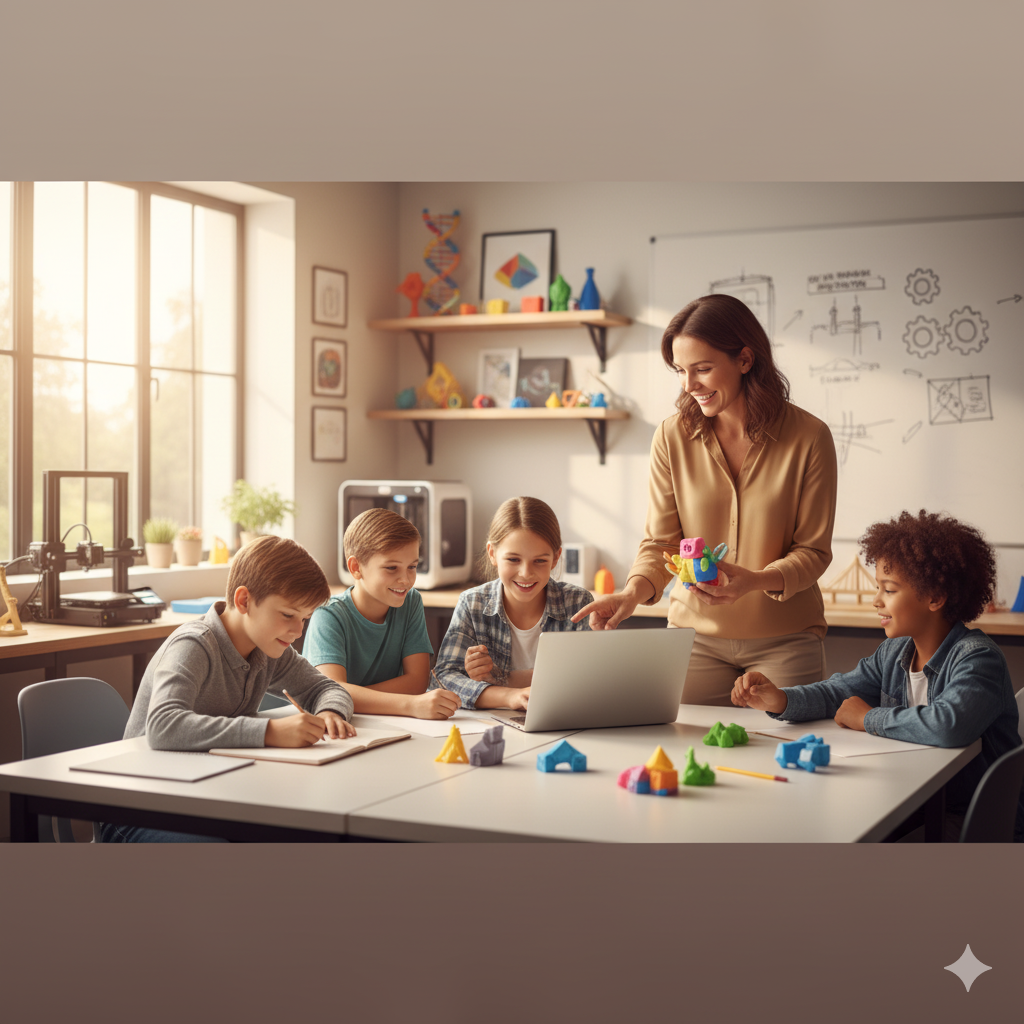Your cart is currently empty!

Changing How We Think About Teaching: It’s Not Just About the Printer
After working with dozens of teachers on 3D printing integration, I’ve noticed something: the biggest challenge isn’t technical. It’s not learning the software or understanding print settings or troubleshooting failed prints.
The biggest challenge is the mindset shift.
Teachers don’t need to learn how to use a 3D printer. They need to reimagine what’s possible in their classroom.
Two Levels of Integration
When I talk to teachers about 3D printing, I see two distinct levels of integration, and both are valuable.
The Surface Level: Creating Magic
At its simplest, 3D printing creates tangible, visually interesting manipulatives that engage students – especially in primary grades. There’s genuine educational value in this.
A child holding a geometric shape they watched emerge from a printer, layer by layer, experiences something different than holding a store-bought block. There’s wonder in the process itself. The “magic” of watching an object materialize captures attention and creates engagement that traditional materials often can’t match.
This level matters. Engagement is not trivial. Excited, curious students are ready to learn.
The Deep Level: Building Creators
But the real transformation happens when we use 3D printing to fundamentally change how students think.
Not as consumers of education, but as inventors. As creators. As problem-solvers who see a need and design a solution.
When sixth graders design a better air hockey puck because theirs keeps breaking, they’re not just learning about 3D printing. They’re learning to approach the world as people who can make things better.
When fifth graders collaborate to design a robot from geometric shapes, they’re not just learning geometry. They’re learning that abstract concepts become tools for creation.
This is the crucial skill for modern life. Technology isn’t slowing down. The world our students are entering values people who can adapt, create, and solve problems that don’t exist yet. 3D printing in education isn’t really about the printer – it’s about developing that inventor mindset.
It’s Not Using a Printer, It’s Integrating a Process
Here’s what doesn’t work: buying a 3D printer, putting it in the corner, and occasionally printing something to supplement a lesson.
That’s using a printer. It’s not integration.
Integration means changing your teaching approach. It means looking at your curriculum and seeing creation opportunities everywhere. It means understanding that your role shifts from information deliverer to facilitator of student-driven problem-solving.
The printer is just the tool. The real change is in how we teach.
Any Subject Can Benefit
I’ve heard teachers say, “Well, 3D printing works for STEM subjects, but I teach language arts” or “That’s great for older students, but I teach kindergarten.”
Here’s what I’ve learned: any subject can deeply benefit from 3D printing. The question isn’t whether it fits your subject – it’s whether you can see the opportunities.
Geography becomes topographical models students design. History becomes artifacts they recreate. Language arts becomes story elements students bring to life. Mathematics becomes manipulatives that make abstract concepts concrete.
The trifacta I designed in an hour? That transformed how students understood multiplication. The Georgian geography board game? That connected students to their cultural identity in ways textbooks couldn’t. The geometric robot? That turned a standard geometry lesson into collaborative design thinking.
None of these required abandoning curriculum. They required seeing curriculum through a different lens.
The One Big Mistake
The most common mistake I see: printing for the sake of printing.
A teacher learns about 3D printing, gets excited, and starts looking for any excuse to use it. They print decorative items, novelties, things that look cool but don’t serve real learning purposes.
This isn’t just inefficient – it teaches students the wrong lesson. It positions 3D printing as a gimmick rather than a powerful tool for creation and problem-solving.
Before printing anything, ask: Does this serve a genuine educational purpose? Does it help students understand something better, create something meaningful, or solve a real problem?
If the answer is just “it’s cool” or “students will like it,” reconsider.
When NOT to Use 3D Printing
3D printing isn’t always the answer, and that’s okay.
Don’t use it when:
- The concept is better taught through physical movement or direct experience
- Two-dimensional visualization is sufficient for understanding
- The print time significantly exceeds the learning benefit
- It’s purely decorative without educational function
- You’re using it just because it’s available
The goal isn’t to print everything. It’s to use 3D printing when it genuinely enhances learning in ways other methods can’t.
The Shift That Matters
If you’re a teacher reading this and thinking about integrating 3D printing, start here: Don’t think about the printer. Think about your students.
What do they struggle to visualize? What concepts remain abstract no matter how you explain them? What problems do they notice in their daily school life? What would excite them to create?
The printer is just the means. The transformation happens when students start seeing themselves as people who can design solutions, create tools, and bring ideas to life.
That’s the mindset shift that matters.
One response to “Changing How We Think About Teaching: It’s Not Just About the Printer”
-
Question: what is “language arts”? I mean I’ve heard of language and I’ve heard of arts, so what do those two make when combined… just curious :))

Leave a Reply to Ana Cancel reply